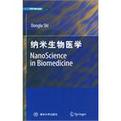纳米生物医学
2009-1
清华大学出版社
时东陆 主编
711
无
本书主要介绍了纳米生物医学研究领域的新进展。本书分为三部分,第一部分叙述了纳米尺度的生物材料的设计、合成、特性以及应用,包括干细胞和相关技术、聚合体纳米纤维及其生物医学应用、自组织生物材料及其生物医学应用、生物探测材料的合成和自组织、磷酸盐陶瓷的生物领域的应用、生物材料的表面和界面特性、碳纳米管在生物传感方面的应用等;第二部分详细介绍纳米尺度的生物医学的新技术,包括药物输运技术、生物医学领域的微纳技术、DNA技术、纳米尺度的生物活性表面和移植、碳纳米管智能材料在生物和医学方面的应用等。第三部分的重点是纳米材料合成和结构的最新进展,包括纳米材料中的声子行为、纳米粒子和纳米流体的合成和特性的最新进展等。 本书由工作在世界纳米生物医学领域的杰出科学家撰写。本书的读者对象为相关专业高年级大学生、研究牛、科技人员、工程技术人员。
1 Stem Cells and Nanostructured Materials2 Biomedical Polymer Nanofibers for Emerging Technology3 Nanoscale Mechanisms For Assembly of Biomaterials4 Fabrication and Assembly of Nanomaterials and Nanomaterials and Nanostrucures for bioological detections5 Nanostructured Materials Constructed from Polypeptides6 Photoluminescent Carbon Nanomaterials:Properties and Potential Applications7 Microwave-assisted Synthesis and Processing of Biomaterials8 Characterizing Biointerfaces and Biosurfaces in Biomaterials Design9 Carbon Nanotubes for Electrochemical and Electronic Biosensing Applications10 Heparin-Conjugated Nanoiterfeces for Biomedical Applications11 Inorganic Nanoparticles for Biomedical Applications12 Nano Metal Particles for Biomedical Applications13 Micro-and Nanoscale Technologies in High-Throughput Biomedical Experimentation14 Delivery System of Bioactive Molecules for Regenerative Medicine15 Modification of Nano-sized Materials for Drug Delivery16 Polymeric Nano Micelles as a Drug Carrier17 DNA Nanotechnology18 Nanoscale Bioactive Surfaces and Endosseous Implantology19 Carbon Nanotube Smart Materials for Biology and Medicene20 Microscopic Modeling of Phonon Modes in Semiconductor Nanocrystals21 Fracture Processes in Advanced Nanocrystalline22 Synthesis,Properties and Application of Conducting PPY Nanoparticles23 Field Emission of Carbon Nanotubes24 Flexible Dye-Sensitized Nano-Porous Films Soar Cells25 Magnetic Nanofluids:Synthesis and Structure
插图:Peptides provide an attractive profile of materials properties that make themunique building blocks for nanoscale materials。Because aqueous self-assemblyprocesses are employed in many materials applications of peptides,these materialstend to be sensitive to pH,ionic strength,temperature,and other factors fromwhich stimulus-responsive strategies can be built.Moreover,peptide materialscan be bioactive,particularly when their design mimics functional elements ofnative proteins.Additionally,being accessible synthetically,peptide materials areby nature easily tailored,and the materials from which they are built arelikewisehighly engineerable.This aspect arises from these materials’inherent modularity.5.4.1 Stimulus.ResponsivenessGiven that many peptide-based materials are constructed through peptide foldingand aqueous self-assembly,the factors that govem these processes are convenienttriggers for rapidly altering the properties of these materials.Self-assemblymechanisms are covered in depth in this book in the chapter by Sui and Murphyentitled‘Nanoscale Mechanisms for Assembly of Biomaterials’.In particular,self-assembly iS sensitive to pH,ionic strength,temperature,and CO.solvents.Stimulus-responsiveness IS a usefu!property that enables such applications astriggered release of drug payloads,injectable gels for minimally invasive surgery,or tnosensmg,where changes in the sensing environment trigger large scalechanges m the properties of the material.Here we will provide a few examples ofPcptide-based materials that employ such strategies.For a more complete reviewof stimulus.responsive peptide-based biomaterials,see(Mart et a1.2006). In 13-sheet fibrils,many strategies for producing stimulus.sensitive materialshave capitalized on the sensitivity of p.sheet fibril assembly to the presence ofsalts.As described in Sec.5.3.1,p.sheet fibrillization is dramatically acceleratedwhen salts are present in solution.
《纳米生物医学》由工作在世界纳米生物医学领域的杰出科学家撰写。《纳米生物医学》的读者对象为相关专业高年级大学生、研究牛、科技人员、工程技术人员。

无
书很好,不错,正版的